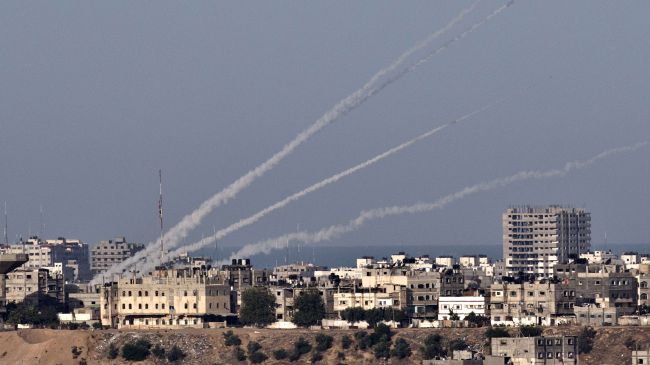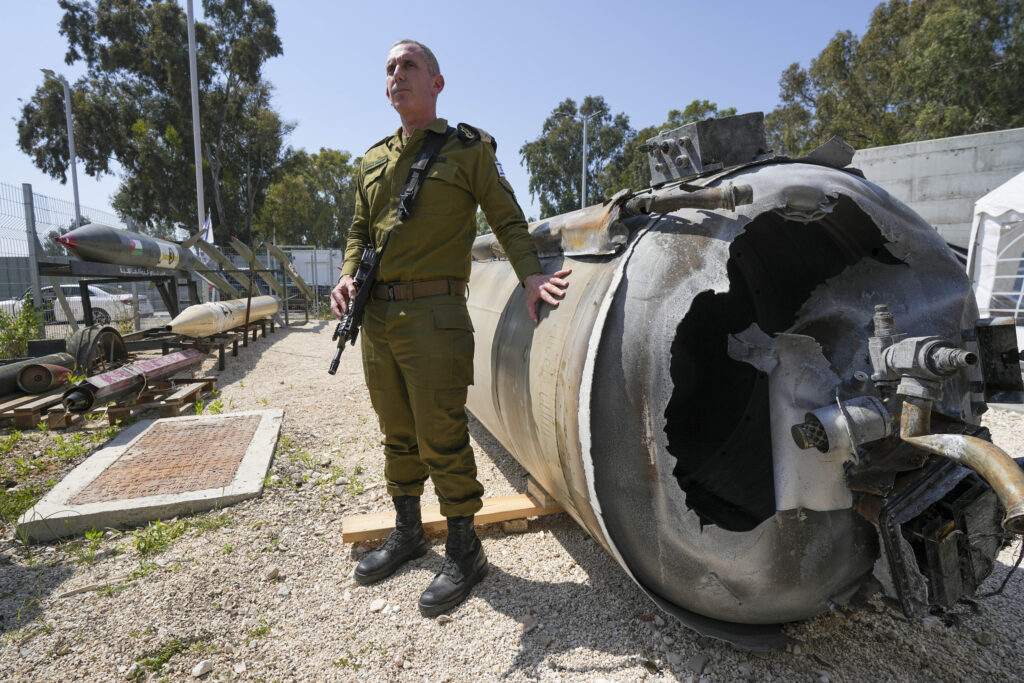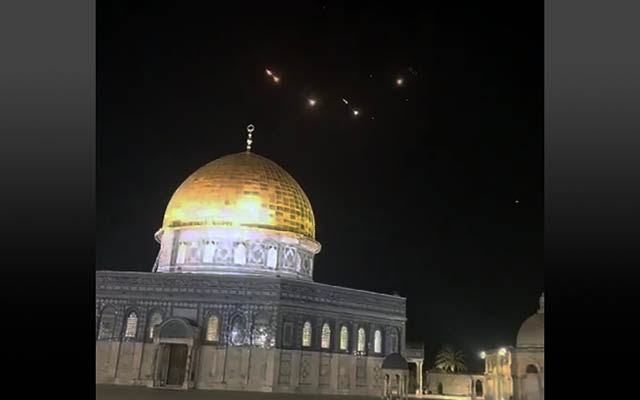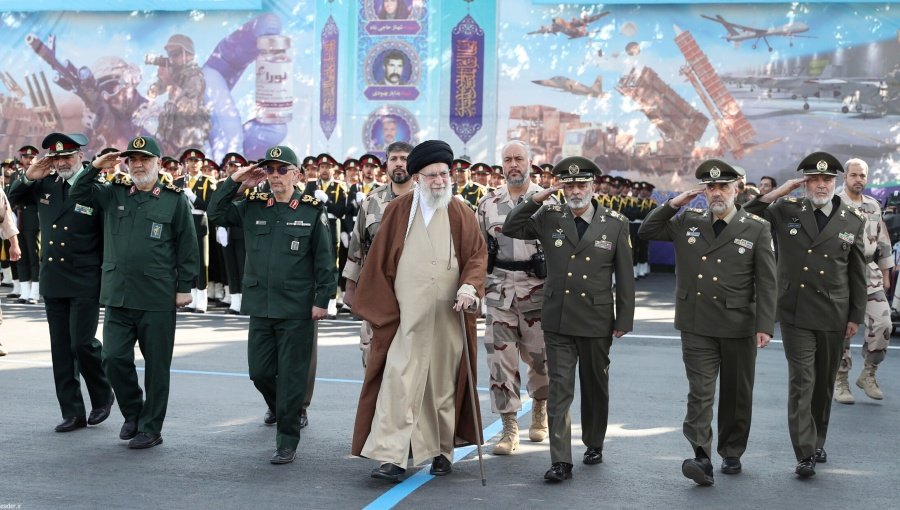UPDATES
AIJAC response to the Canberra Declaration on Gaza
Aug 15, 2014 | AIJAC

71 current and five former members of Australian Federal and State parliaments, mostly Labor and Greens, but also Malcolm Fraser and some independents, have signed what they call the “Canberra Declaration on Gaza” (the Declaration), calling on “all Australian politicians to condemn the ongoing Israeli military bombardment and invasion of Gaza.”
A link to the Declaration is here. The Declaration reflects a one-sided and misguided view of the current conflict in Gaza, and of the Israeli/Palestinian situation in general. This document explains why.
Condemning only Israel
It is notable that in the first sentence, the Declaration condemns Israel’s bombardment and invasion of Gaza, but does not condemn Hamas for firing over 3000 rockets at Israeli civilians, or the tunnels into Israel that were built specifically to infiltrate into the country to carry out mass terror attacks. Hamas rockets can now reach most of Israel, including the major population centres Tel Aviv and Jerusalem, and can shut down the national airport, the nations lifeline.
Israel initially responded by hitting back in a very low intensity manner, while sending a message to Hamas on July 3 that “quiet will be met with quiet”, adding “Israel has no interest in an escalation. If Hamas reins in the shooting now, we won’t act either.” Unfortunately, Hamas rejected this offer, and responded by launching a volley of 80 rockets on July 6. It also rejected an Egyptian proposal for ceasefire on July 15, which Israel accepted.
No country would allow its civilians to be subjected to such an unprovoked barrage, and no-one can fairly claim that Israel should. Israel responded in self-defence by targeting the terrorist infrastructure in Gaza. Israel has observed several ceasefires, but each so far has been breached by Hamas, with some being ignored altogether.
In the course of its military action, Israel discovered that the tunnel network into Israel was far more elaborate and extensive than it had realised, with numerous tunnels surfacing near Israeli townships and kibbutzim near Gaza. Captured Hamas operatives have admitted that Hamas had planned to use the tunnels for a mass infiltration into Israel. Up to 1,000 well-armed terrorists would have stormed several communities, slaughtering and kidnapping Israeli civilians. Anaesthetics and binding materials found in some of the tunnels bear witness to this plan.
Given the twin threats of the rockets and the tunnels, Israel had no choice but to act to protect its citizens. Yet the Declaration does not condemn the party that sparked the current Gaza conflict with illegal acts, only the party that has legally responded to them.
Calling for an end to occupation
The Declaration calls for an end to Israel’s occupation of “Palestinian territories”. UN Security Council resolution 242, as well as the “Roadmap to peace” signed off by the UN, EU, USA and Russia, require the final borders between Israel and the ultimate Palestinian state to be negotiated as part of a broader resolution which also requires the Palestinians to accept Israel’s right to exist in peace behind secure borders. To simply state that Israel occupies or must unilaterally withdraw from territories denoted as Palestinian (a term without basis in international law, at least until a Palestinian state is negotiated) is in contradiction of these precedents, which underpin the entire peace process, and is thus counter-productive to the cause of peace.
Peace will require both sides to make concessions, and the international community must insist that they do. To simply require one side, Israel, to withdraw thus giving the Palestinians what they want without any concessions on their part, is unhelpful in this context. The conflict is not only about land. Other issues include the Palestinian leadership’s demand of a right of return of millions of descendants of refugees to Israel, not to a future Palestinian state, as well as Israel’s legitimate security concerns, in particular Hamas’ control of the Gaza Strip and its commitment to violently destroy Israel.
In 2000, 2001 and 2008, Israel offered the Palestinians a state in all of Gaza and the vast majority of the West Bank, with land swapped from pre-1967 Israel in compensation for the settlement blocs Israel was to keep. There was also to be a Palestinian capital in East Jerusalem and compensation for refugees, among other concessions. On each occasion, the Palestinians did not accept these offers, or even make a counter offer.
Gaza itself is not occupied in any sense of the word. In 2005, Israel totally evacuated Gaza, including removing around 8,000 settlers, with the intention of allowing Palestinian self-rule there as a precursor to further withdrawals in the West Bank. Territory is considered occupied when it is actually placed under the authority of the hostile army. International law is very clear on what constitutes occupancy, with Article 42 of the Hague Regulations stating that the occupation extends only to the territory where such authority has been established and can be exercised. It is absurd to argue that this applies to the Gaza Strip since 2005.
Calling for an end to the blockade
The Declaration also calls for a cessation to the blockade of Gaza. The blockade is only a partial blockade. It only keeps out goods and materials that have a military use. All other goods – food, medicine, consumer goods – are allowed to enter Gaza in whatever quantities Palestinian authorities request, while Israel itself supplies water, fuel and electricity. In the past two years, Israel has been allowing in concrete for the rebuilding of houses and civilian facilities, but it has now emerged that much of that concrete was diverted to the building of the terror tunnel network.
When Israel withdrew from Gaza in 2005, as mentioned above, it left greenhouses to facilitate agriculture in the area. The intention was that once the Palestinians co-existed adjacent to Israel, more peaceful gestures would ensue and ultimately lead to peace. Unfortunately, the greenhouses were smashed and the flow of rocket fire into Israel immediately increased.
While Hamas won the most seats in legislative election in 2006, it illegally seized executive power in the Gaza Strip by the violent ouster of the rival Fatah faction in 2007. It was only due to an escalation in rocket fire that Israel imposed a security blockade in 2007 to stop the flow of weapons into Gaza. In September 2011, a panel of inquiry commissioned by the UN Secretary General and chaired by former New Zealand prime minister and professor of law, Sir Geoffrey Palmer found that Israel’s blockade of Gaza was legal under international law and was a “legitimate security measure in order to prevent weapons from entering Gaza” given the “real threat to Israel’s security from militant groups in Gaza.” Israel has frequently stopped the transfer of vessels bound for Gaza with sophisticated missiles.
If it wasn’t for the blockade, Hamas would no doubt have had an even greater number of rockets, and most likely more sophisticated and deadly versions, and the tunnels would have been even more extensive, and completed earlier, which would probably mean the planned mass terrorist attack would already have occurred. To remove the security blockade now in its entirety would not only allow Hamas to more effectively pursue its murderous terrorist agenda, but would also reward it for initiating the current violence. In a world where there are many terrorist threats to the West, this would be precisely the wrong message to send, as it would be encouraging terrorism by showing it works, rather than discouraging it. In the context of Israel, it would simply sow the seeds for another, no doubt more deadly, confrontation. It is not reasonable to demand the blockade be lifted without measures to prevent Hamas’ rearmament, which would only lead to further conflict.
Calling for support for the UNHCR inquiry
The Declaration calls on Australian politicians to support the United Nations Human Rights Council’s enquiry into purported violations of international law in this conflict and more generally in the “Occupied Territories, including East Jerusalem”. The UNHCR is notoriously biased against Israel. Since its establishment in 2006, it has passed a total of 103 resolutions. Despite the many gross violations of human rights all around the world in that time, 56 of those resolutions have focussed on criticising Israel.
The resolution calling for the inquiry does not even mention Hamas, even though it is widely recognised that Hamas is committing war crimes by both indiscriminately firing at Israeli civilians and by subsuming its military infrastructure and its military activities among Gaza’s civilian population and infrastructure. The terms of the referral already proclaim Israel guilty of war crimes, leaving virtually no room for the Commissioners to declare Israel not guilty. There is practically no chance of the so-called independent inquiry being fair, balanced or just. Following Israel’s Operation Cast Lead in Gaza in 2008/9, under similar circumstances, the UNHCR report was so one-sided that the head of the commission, Justice Goldstone, ultimately dissociated himself from it.
Casualty figures
The Declaration states that the United Nations says at least 75% of the dead in Gaza have been civilians. There is no doubt that many civilians in Gaza have been killed, and every civilian death is a tragedy. However, it’s important to examine these figures more closely.
The UN ultimately obtains its figures from the Gaza Health ministry, controlled by Hamas. Hamas has a vested interest in exaggerating the numbers of civilian casualties to place international pressure on Israel. Half of the population of Gaza is 15 years of age and below, and half is female. Yet independent analysis of the casualty ages and genders as reported in the media demonstrates that most of those killed are men over the age of 15, or, in other words, men of combat age. Israel estimates that around half of those killed have been known militants, with other casualties also men of combat age who have not been identified as fighters.
Moreover, deaths that have not been caused by the Israeli military actions are included in the casualty count, including those who have died of natural causes, or been executed by Hamas as “collaborators” or because they are political opponents. Moreover, more than 280 Palestinian rockets have also fallen short of Israel and landed in the Gaza Strip, some in civilian areas including a hospital and UN refugee camp on July 28, causing civilian casualties that are then blamed on Israel.
During Operation Cast Lead in 2008/9, it was generally claimed that most of the casualties were civilians. Hamas had been claiming that only 50 of those killed were its fighters. However, in the months following that violence, even Hamas admitted that around 700 of the 1,100 to 1,200 killed were its fighters.
Rockets can’t be compared with Israel’s bombing
The Declaration is absolutely correct that the rockets can’t be compared with Israel’s weaponry. As stated by Ibrahim Kraishi, the Palestinian representative to the UNHCR, speaking on Palestinian TV about the risks of taking action against Israel for alleged war crimes in the current conflict, “The missiles that are now being launched against Israel, each and every missile constitutes a crime against humanity, whether it hits or misses, because it is directed at civilian targets.”
“Many of our people in Gaza appeared on TV and said that the Israelis warned them to evacuate their homes before the bombardment. In such a case, if someone is killed, the law considers it a mistake rather than an intentional killing because [the Israelis] followed the legal procedures.”
“As for the missiles launched from our side, we never warn anyone about where these missiles are about to fall or about the operations we carry out.”
As Ambassador Kraishi so clearly stated, the difference, in terms of international law, between the rockets from Hamas and the other Palestinian terror groups and the Israeli military operation is that the rockets are war crimes and the Israel’s military operation is not.
Of course, Israel’s weapons are far stronger and more destructive, but that is not the point in international law. The international law doctrine of proportionality does not mean that you can only hit the other side as hard as they hit you. That would be ludicrous, and no war has ever been fought according to those limitations.
The doctrine of proportionality means that the force used must be proportionate to the legitimate military aim. Once it is established that Israel has the right to destroy Hamas’ terrorist infrastructure, it is entitled, at international law, to use the force required to achieve that, provided it takes reasonable steps to avoid civilian casualties. As the Ambassador states above, Israel has done this by warning civilians to evacuate or seek alternate shelter, by means of leaflet drops, phone calls, text messages and even dropping bombs with a very weak explosion onto buildings to be targeted. There have also been many examples when Israel has aborted an intended strike because of the presence of civilians in the target area.
Collective punishment
The Declaration states, correctly, that collective punishment is not permitted, and is a war crime. However, the clear implication that Israel is carrying out collective punishment is not correct. A stated above, Israel, in exercise of its legitimate right of self-defence, is legally entitled to attack the Gaza terrorist or military infrastructure, and that is what it has done. Fighting a war has never before been considered “collective punishment” in international law, and neither has a blockade.
Hamas, in a further war crime to add to its indiscriminate targeting of Israeli civilians, hides its military infrastructure in houses and other civilian buildings. Many of the houses Israel has bombed contain weapons, or are used to launch rockets. Others are command centres or hide tunnel entrances.
Former US President Bill Clinton said, “Hamas was perfectly well aware what would happen if they started raining rockets on Israel. They fired a thousand of them, and they have a strategy designed to force Israel to kill their own civilians so that the rest of the world will condemn them.” Hamas benefits strategically when Israel kills civilians in Gaza, and has even gone so far as to encourage civilians to act as shields on buildings Israel has given notice it is about to bomb, and has ordered civilians to ignore Israeli advice to evacuate areas about to be attacked.
The area that has suffered the most widespread damage is Shujaiya, but that was the result of an intense military battle, not of any collective punishment. The area was a hotbed of rocket attacks and tunnel entrances. Israeli troops who entered the area were attacked from all sides by militants hiding in houses and tunnels. Many of the houses were also booby-trapped. The Israeli forces needed to subject the area to an artillery barrage to rescue the soldiers.
Hospitals, places of worship, centre for the disabled targeted
Hospitals and mosques damaged by Israel have contained extensive terrorist infrastructure, and Israel has given the Palestinians time to evacuate them. Footage has emerged of mosques with tunnel entrances stocked with weapons. Footage also shows hospitals that have been targeted rocked by secondary explosions, demonstrating that Israel’s attack struck weapons and ammunition.
It is an open secret that the main Hamas operations centre in Gaza is in the al Shifa Hospital, Gaza’s largest hospital. The Washington Post reported on July 15 that Al-Shifa Hospital in Gaza City has become “a de facto headquarters for Hamas leaders, who can be seen in the hallways and offices.” Wafa Hospital was also reportedly turned into a command center, rocket-launching site, observation point, sniper’s post, weapons storage facility, cover for tunnel infrastructure, and a general base for attacks against Israel and IDF forces. Hamas has also reportedly threatened journalists to refrain from reporting on these incidents. For example, Italian reporter Gabriele Barbati tweeted, “Out of #Gaza far from #Hamas retaliation: misfired rocket killed children today in Shati. Witness: militants rushed and cleared debris.”
A solution of justice and peace
The Declaration concludes by calling on the international community to put pressure on Israel to end its attacks on Gaza and broker a solution of justice and peace. Again, it is notable that the declaration does not call on the international community to pressure Hamas to end its attacks on Israeli civilians.
The only solution that will prevent this violence being repeated in a year or two, by Hamas provoking another conflict as it did in 2009 and 2012, is for Hamas to be disarmed and Gaza to be demilitarized, in exchange for significant investment in Gaza’s reconstruction. This view has been supported by statements made by the US, EU, Canada, Arab states and the Palestinian Authority.
This will indeed require the international community to not only put pressure on the relevant parties, including Hamas supporters and funders such as Qatar, Turkey and Iran, but also contribute to the enforcement of the demilitarization.
Hamas has made it clear repeatedly that its aim is the violent destruction of Israel. Hamas does not just aspire to a Palestinian state in what the Declaration calls the Palestinian territories, or even in all of Israel. What it actually aspires to is an Islamic Caliphate. It is regarded by most of the Western world, including Australia, as a terrorist organisation and, as such, should not be permitted to re-establish its military arsenal.
While Hamas and other jihadist groups will likely not give up their arms, Hamas will find it more difficult to rearm since Egypt has destroyed its smuggling tunnels that reached from Gaza into Egypt. Egypt could also ease restrictions on its Rafah border, while ensuring that weapons are not smuggled in to Gaza.
For there to be progress towards peaceful reconciliation, control of the Gaza Strip will likely need to revert to the Palestinian Authority, and this, too, will require international support. Once a scheme is in place whereby Hamas can no longer use Gaza as its terrorist enclave, the blockade can be downgraded and eventually removed, and the Strip rehabilitated. Again, this will require international support, and Australian should play its part.
In the longer term, a demilitarized Gaza Strip would also improve prospects of peace, which will only come through a two-state resolution along the lines of that offered by Israel to the Palestinians in 2000, 2001 and 2008, as set out above. For that to happen, the Palestinians will need to genuinely accept Israel’s right to exist in peace, which will entail among other things, accepting an end to all further claims against Israel and accepting that the now millions of descendants of refugees can return to the new Palestinian state, but not to Israel.
Again, the international community will need to convince the Palestinians to accept these compromises. This will only happen if they take a measure of responsibility for their own plight, and for bringing that plight to an end. That will never happen as long as the Palestinians are led to believe that the international community blames the situation only on Israel, and that the Palestinians, therefore, need only wait and ultimately they will get their state without needing to make the necessary compromises.
Documents such as this Declaration, which unfairly and erroneously blames Israel for the current violence, are counter-productive, do damage to the cause of peace, and, rather than benefitting the Palestinian people, actually serve only to perpetuate the conflict.
Tags: Australasia











